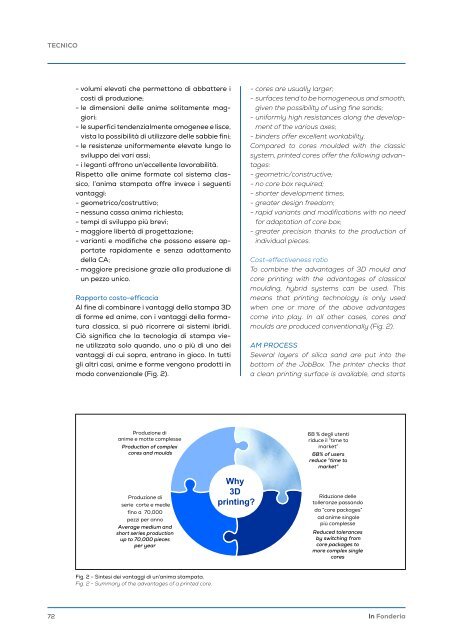In Fonderia 1 2024
Primo numero del 2024 di In Fonderia
Primo numero del 2024 di In Fonderia
Create successful ePaper yourself
Turn your PDF publications into a flip-book with our unique Google optimized e-Paper software.
TECNICO<br />
- volumi elevati che permettono di abbattere i<br />
costi di produzione;<br />
- le dimensioni delle anime solitamente maggiori:<br />
- le superfici tendenzialmente omogenee e lisce,<br />
vista la possibilità di utilizzare delle sabbie fini;<br />
- le resistenze uniformemente elevate lungo lo<br />
sviluppo dei vari assi;<br />
- i leganti offrono un’eccellente lavorabilità.<br />
Rispetto alle anime formate col sistema classico,<br />
l’anima stampata offre invece i seguenti<br />
vantaggi:<br />
- geometrico/costruttivo;<br />
- nessuna cassa anima richiesta;<br />
- tempi di sviluppo più brevi;<br />
- maggiore libertà di progettazione;<br />
- varianti e modifiche che possono essere apportate<br />
rapidamente e senza adattamento<br />
della CA;<br />
- maggiore precisione grazie alla produzione di<br />
un pezzo unico.<br />
Rapporto costo-efficacia<br />
Al fine di combinare i vantaggi della stampa 3D<br />
di forme ed anime, con i vantaggi della formatura<br />
classica, si può ricorrere ai sistemi ibridi.<br />
Ciò significa che la tecnologia di stampa viene<br />
utilizzata solo quando, uno o più di uno dei<br />
vantaggi di cui sopra, entrano in gioco. <strong>In</strong> tutti<br />
gli altri casi, anime e forme vengono prodotti in<br />
modo convenzionale (Fig. 2).<br />
- cores are usually larger;<br />
- surfaces tend to be homogeneous and smooth,<br />
given the possibility of using fine sands;<br />
- uniformly high resistances along the development<br />
of the various axes;<br />
- binders offer excellent workability.<br />
Compared to cores moulded with the classic<br />
system, printed cores offer the following advantages:<br />
- geometric/constructive;<br />
- no core box required;<br />
- shorter development times;<br />
- greater design freedom;<br />
- rapid variants and modifications with no need<br />
for adaptation of core box;<br />
- greater precision thanks to the production of<br />
individual pieces.<br />
Cost-effectiveness ratio<br />
To combine the advantages of 3D mould and<br />
core printing with the advantages of classical<br />
moulding, hybrid systems can be used. This<br />
means that printing technology is only used<br />
when one or more of the above advantages<br />
come into play. <strong>In</strong> all other cases, cores and<br />
moulds are produced conventionally (Fig. 2).<br />
AM PROCESS<br />
Several layers of silica sand are put into the<br />
bottom of the JobBox. The printer checks that<br />
a clean printing surface is available, and starts<br />
Produzione di<br />
anime e motte complesse<br />
Production of complex<br />
cores and moulds<br />
68 % degli utenti<br />
riduce il “time to<br />
market”<br />
68% of users<br />
reduce “time to<br />
market”<br />
Produzione di<br />
serie corte e medie<br />
fino a 70,000<br />
pezzi per anno<br />
Average medium and<br />
short series production<br />
up to 70,000 pieces<br />
per year<br />
Why<br />
3D<br />
printing?<br />
Riduzione delle<br />
tolleranze passando<br />
da “core packages”<br />
ad anime singole<br />
più complesse<br />
Reduced tolerances<br />
by switching from<br />
core packages to<br />
more complex single<br />
cores<br />
Fig. 2 - Sintesi dei vantaggi di un’anima stampata.<br />
Fig. 2 - Summary of the advantages of a printed core.<br />
72<br />
2<br />
Congresso Assofond 2022- Sessione Tecnica<br />
<strong>In</strong> <strong>Fonderia</strong>














